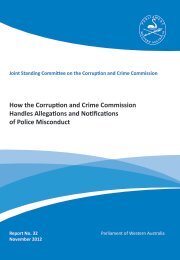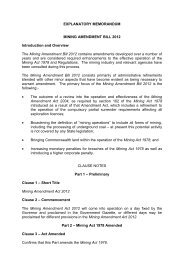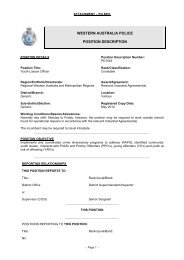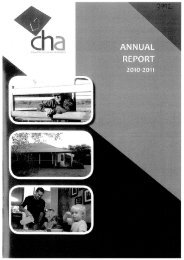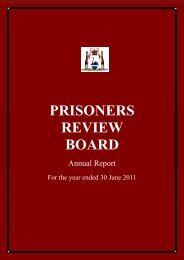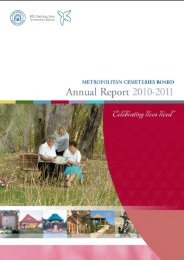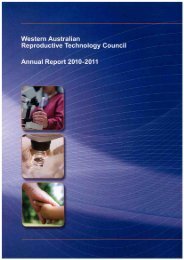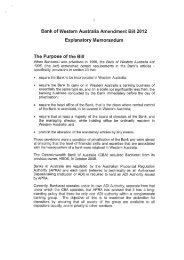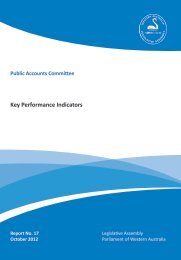Zoological Parks Authority - Parliament of Western Australia - The ...
Zoological Parks Authority - Parliament of Western Australia - The ...
Zoological Parks Authority - Parliament of Western Australia - The ...
Create successful ePaper yourself
Turn your PDF publications into a flip-book with our unique Google optimized e-Paper software.
<strong>Zoological</strong> <strong>Parks</strong> <strong>Authority</strong> ANNUAL REPORT 2012<br />
Disclosures and Legal Compliance<br />
Financial Statements<br />
<strong>Zoological</strong> <strong>Parks</strong> <strong>Authority</strong><br />
Notes to the Financial Statements for the Year Ended 30 June 2012 continued<br />
(i)<br />
(j)<br />
Each relevant class <strong>of</strong> assets is reviewed annually to verify that the accumulated<br />
depreciation/amortisation reflects the level <strong>of</strong> consumption or expiration <strong>of</strong><br />
asset’s future economic benefits and to evaluate any impairment risk from falling<br />
replacement costs.<br />
<strong>The</strong> recoverable amount <strong>of</strong> assets identified as surplus assets is the higher <strong>of</strong><br />
fair value less costs to sell and the present value <strong>of</strong> future cash flows expected<br />
to be derived from the asset. Surplus assets carried at fair value have no risk<br />
<strong>of</strong> material impairment where fair value is determined by reference to marketbased<br />
evidence. Where fair value is determined by reference to depreciated<br />
replacement cost, surplus assets are at risk <strong>of</strong> impairment and the recoverable<br />
amount is measured. Surplus assets at cost are tested for indications <strong>of</strong><br />
impairment at the end <strong>of</strong> each reporting period.<br />
Refer note 26 ‘Impairment <strong>of</strong> assets’ for the outcome <strong>of</strong> impairment reviews<br />
and testing.<br />
Non-current assets (or disposal groups) classified as held for sale<br />
Non-current assets (or disposal groups) held for sale are recognised at the lower<br />
<strong>of</strong> carrying amount and fair value less costs to sell, and are disclosed separately<br />
from other assets in the Statement <strong>of</strong> Financial Position. Assets classified as<br />
held for sale are not depreciated or amortised.<br />
Leases<br />
Finance lease rights and obligations are initially recognised, at the<br />
commencement <strong>of</strong> the lease term, as assets and liabilities equal in amount to<br />
the fair value <strong>of</strong> the leased item or, if lower, the present value <strong>of</strong> minimum lease<br />
payments, determined at the inception <strong>of</strong> the lease. <strong>The</strong> assets are disclosed as<br />
plant, equipment and vehicles under lease, and are depreciated over the period<br />
during which the <strong>Authority</strong> is expected to benefit from their use. Minimum lease<br />
payments are apportioned between the finance charge and the reduction <strong>of</strong> the<br />
outstanding lease liability, according to the interest rate implicit in the lease.<br />
Finance lease liabilities are allocated between current and non-current<br />
components. <strong>The</strong> principal component <strong>of</strong> lease payments due on or before the<br />
end <strong>of</strong> the succeeding year is disclosed as a current liability, and the remainder<br />
<strong>of</strong> the lease liability is disclosed as a non-current liability.<br />
(k) Financial instruments<br />
In addition to cash, the <strong>Authority</strong> has two categories <strong>of</strong> financial instrument:<br />
– Loans and Receivables; and<br />
– Financial liabilities measured at amortised cost.<br />
(l)<br />
Financial instruments have been disaggregated into the following classes:<br />
Financial Assets<br />
– Cash and cash equivalents<br />
– Restricted cash and cash equivalents<br />
– Receivables<br />
– Amounts receivable for services<br />
Financial Liabilities<br />
– Payables<br />
– Finance lease liabilities<br />
Initial recognition and measurement <strong>of</strong> financial instruments is at fair value<br />
which normally equates to the transaction cost or the face value. Subsequent<br />
measurement is at amortised cost using the effective interest method.<br />
<strong>The</strong> fair value <strong>of</strong> short-term receivables and payables is the transaction cost<br />
or the face value because there is no interest rate applicable and subsequent<br />
measurement is not required as the effect <strong>of</strong> discounting is not material.<br />
Cash and cash equivalents<br />
For the purpose <strong>of</strong> the Statement <strong>of</strong> Cash Flows, cash and cash equivalent<br />
(and restricted cash and cash equivalent) assets comprise cash on hand<br />
and short-term deposits with original maturities <strong>of</strong> three months or less that<br />
are readily convertible to a known amount <strong>of</strong> cash and which are subject to<br />
insignificant risk <strong>of</strong> changes in value, and bank overdrafts.<br />
(m) Accrued salaries<br />
Accrued salaries (refer note 27 ‘Payables’) represent the amount due to staff<br />
but unpaid at the end <strong>of</strong> the financial year. Accrued salaries are settled within a<br />
fortnight <strong>of</strong> the financial year end. <strong>The</strong> <strong>Authority</strong> considers the carrying amount<br />
<strong>of</strong> accrued salaries to be equivalent to its net fair value.<br />
75



